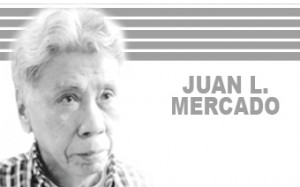 English today is “the most widely learned second language.†Scientists write in it. Major newspapers and 24-hour stations use it. So do international air traffic controllers, businessmen and diplomats.
English today is “the most widely learned second language.†Scientists write in it. Major newspapers and 24-hour stations use it. So do international air traffic controllers, businessmen and diplomats.
But its versions vary widely. Look at how Filipinos use it.  This is language where there’s more English than Tagalog words.
Make cuento to me what happened,†says your neighbor. Or “Let’s make tusok the fishballs,†suggests a friend. Then there’s the superlative: “He’s so galing.â€
What happens when the proportion of English words is reversed? That’s when we get “Taglish.†“I’m so init na; make paypay me naman.â€
English “as she is speak†has stunning varieties, whether used for the banal or profound.
An Easter Sunday homily by the, the Jesuit theologian Caralino Arevalo recalls how disciples, on the road to Emmans, didn’t recognize the Man they spoke to. The tomb was empty as the women said, Cleofas complains to the risen Christ walking alongside. “But him they did not see.
Resurrection changed the Galilean. And Father Arevalo notes our teenagers have a phrase for this: “You are very other na.†Thus, it was only later that the disciples recognized Him, as the gospels tell us, “in breaking of the bread.â€
There are variants like “Colegiala English,†former columnist Bambi Harper claims. Maryknoll? Saint Theresa’s? St. Scho? Assumption? Or Ateneo accent. And so on.
Filipino professionals – doctors, engineers, teachers etc. – tend   to speak this versin. This English-influenced group endeavors to speak. “Straight Englishâ€. Some may on an American or British accent. “By the time the call centers are through with us, we should all sound like we came from Iowa,†Ms. Harper claims.
But nothing beats the one-word Filipinisms that former Manila Times columnist Alfredo Roces emailed from his Australian retirements residence. Get these down pat. And you can scrap those traditional! Pilipino dictionaries, this editor jokes. Here’s a partial list:
Start with the all-around, all-purpose word for everything. “Anoâ€Â (A-noh).
As a noun, you ask: Where’s your ano? (Where’s your father/mother/dead-uncle’s-second-cousin, etc.) It also serves as pronoun in questions like: Ano? (What?). You prefer a verb? Then, say.â€Â Anuhin mo.â€Â It can mean paint or kill or maim or castrate.
Or as adjective?  Filipinos don’t just explode with: “What the hell!â€Â Many of us flip an interjection: Ano!
Above all, it comes handy as the all-purpose question, regardless of whether you deal with traffic gridlocks or obnoxious politicians: “Did you ano your ano?
That way, you can even croon along with the street ballad: “But in truth, my love / I’m so ano with you.
Then there are everyday words.  Consider: Para (pah-rah)! This directs the jeepney driver to stop, usually in the middle of the road, as the individual yelling intends to leap from the vehicle.
Heard of takusa (ta-kuh-sa)? This is derived from takot sa asawa. Scared stiff by the wife, this describes males married to feminine reincarnations of Hitler. What about lagot (Lah-got)? This is a prophesy of evil things to come.
Indyanero (in-jan-neh-ro) is one who doesn’t show up at a meeting. Japorms (Jah-porms) is a person who dresses bizzarely. Kilig (keel-leg) is excitement when one’s sweetie rounds the corner. But gigil (gee-gil) is a near-uncontrollable desire to bite something.
As the nutty song goes: “When I finally got the nerve to date you / I almost became indyanero, / Because I didn’t think I had the right japorms. / When you’re around, I’m kilig / When you’re not, I get gigil.
But what about English “as she is write? That too can be starting. Read this essay on “The Cow.†It was cribbed from an Indian Civil Service exam:
“The cow is a successful animal. Also he is quadruped, and because he is female, he give milk, but will do so when he is got child. He is same like God, sacred to Hindus and useful to man.
“But he has got four legs together. Two are forward and two are afterwards. His whole body can be utilized for use. More so the milk. What can it do? Various butter, cream, curd, why and the condensed milk and so forth.
“Cow is the only animal that extricates his feeding after eating. Then afterwards she chew with his teeth whom are situated in the inside of the mouth. He is incessantly in the meadows in the grass.
“His only attacking and defending organ is the horn, specially so when he is got child. This is done by knowing his head whereby he causes the weapons to be paralleled to the ground of the earth and instantly proceed with great velocity forwards.
“He has got tails also, but not like similar animals. It has hairs on the other end of the other side. This is done to frighten away the flies which alight on his cohoa body whereupon he gives hit with it.
“The palms of his feet are soft unto the touch. So the grasses head is not crushed. At night time have poses by looking down on the ground and he shouts his eyes like his relatives, the horse does not do so.  This is the cow.â€
P.S.: “Very moooooooving.†Ding Roces adds. “We are informed that the candidate passed the exam.â€Â  (Email:  juanlmercado@gmail.com)
By Juan  L.  Mercado
